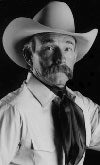In the PowerPoint presentation, it all looks so orderly as the healthy steer standing in the hydraulic chute smiles at the camera while the hired hand in a clean shirt demonstrates a procedure with music playing in the background.
I will remind you, there are still places where a cowboy and a horse are an essential part of management.
For example, feeder cattle on wheat grass or ranches where they still calve “outside” or summer mountain pastures.
These are examples where it is more expedient to treat the critter where you find it rather than try and drive or haul them to a squeeze chute or trap two miles away.
If you have the luxury of a two-man crew, the method is obvious: head and heel them. But for the lone rider, his skills must be at a higher level.
The beast, a cow with a wire around her foot or a steer with pinkeye, must be caught, restrained, treated and released.
Depending on the terrain, the disposition of critter and its size, the job can be hard or harder. In real life, catching can mean the head, the horns, the heels, one hock or the head and front leg together.
Restraining the animal usually means putting them on the ground. Since this lecture could take 10 more pages, illustrated, I will discuss the case of a 300-pound bull calf that needs doctored or branded and cut.
Regardless of the appendage you’ve roped, you can drag him slowly until he eventually lies down.
The next step is restraint. Your horse must keep the rope tight while you dismount. Tie a half-hitch over the dally around the saddle horn.
Throw the coils on the ground away from the action. Wrap a rein around the tight rope and secure it. This will keep the horse’s head pointed to the calf.
Pounce on the ground; make sure the correct side of the calf is dorsal if he’s going to be branded. Slip the piggin’ string loop over the calf’s down-side front leg.
Slide your body back far enough to push both his hind legs forward with your thigh. Arrange his two hind feet to cross over the attached front leg.
Make three wraps around the three feet and pull them together tight. Very tight. Then another tight wrap and a hooey around the attached front leg. The critter is ready to be treated. You can ease your horse up.
This description of our skilled cowboy making the perfect catch and tie-down holds true – unless, of course, your horse lets slack out of your line when he shouldn’t, gets tangled in the coils, the dally slips, you loop the piggin’ string over your wrist, the calf gets loose and runs under the horse’s belly, who then deserts you three miles from the pickup and loses your rope somewhere along the way.
But don’t worry … that never happens … ![]()









